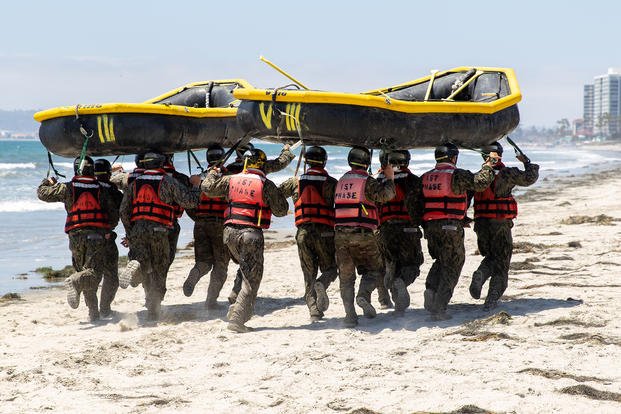People often ask what type of workouts special ops candidates need to do when preparing for challenging selection programs, including running, rucking (load bearing), high-repetition calisthenics and swimming. This is not a typical leg day, but it is common enough that the candidates are not sore from this activity level.
Leg soreness is one of the assessment tools as we progress into workouts such as this over several weeks. The goal is to create workouts to simulate typical training days with logs, boats, running, rucking and/or swimming that the legs can handle without any muscle soreness. It can be done, but you should progress lightly and perhaps start with 30%-50% of the below mileage and repetitions.
Warm-up -- Squat pyramid 1-10, run 50 meters in-between: This is just an easy dynamic warm-up that prepares the legs for the following events. It works like this: Do one air squat, jog 50 meters; two squats, jog 50 meters; three squats, jog 50 meters; and keep going until level 10. It is fine to mix in some leg dynamic stretches, such as butt kickers and leg swings, during sections of the 50-meter jog to warm up the body fully.
Run four miles: Schedule a typical running distance for your upcoming special-ops selection. For instance, prospective SEALs will undergo four-mile timed runs on the beach weekly for the entire six months of training. But if you need to master five-mile runs for Ranger School, three-mile timed runs for the Marine Corps physical fitness test or other distances regularly tested in your selection of choice, do it with relatively fresh legs to start off this workout.
Leg/Core Devil’s Mile: Following the run, this is the meat of the workout that should be progressed over time to accumulate a mile of these four exercises combined. Maybe start with 100-meter sets if this is your first time doing this workout. These are all common events you will likely do at some point in training:
- 400-meter lunges: Lunges with rucks, logs or just on the pool deck are common activities to work the legs. Get used to these at this distance and even more.
- 400-meter fireman’s carry: Injured man drills will be part of your training; carrying your teammate is a skill you need to master.
- 400-meter farmer’s walk: If you are not carrying a stretcher with an injured teammate, you will be carrying equipment. Work the core and grip with this classic. Carry one-handed weight to work the core more and change hands when grip tires in one hand.
- 400-meter bear crawl: Between low-crawling and bear-crawling, you will be required to stay low and move regularly. Consider this activity a total core exercise that works the shoulders, torso and hips.
Not a cooldown: Finish 11-20 sets of the squat pyramid with 50-meter jogs, with dynamic stretches mixed between sets. Just as you start with a pyramid from 1-10, keep going up the pyramid, mixing in jogs and dynamic stretches every set until you reach level 20. Combining the two half-pyramids is a total of 210 squats. If you are not used to that kind of volume, you can return in reverse order (9-1) and end with a total of 100 air squats.
Final cardio (swim or ruck): Depending on your future goals of service, you may be required to ruck much more than swim. Or you may be required to get good at swimming with fins for long distances, too. The next section depends on that choice of service. You can also opt to do either or both if you are at that level of conditioning:
Warm up with 500 meters (no fins)/five-minute tread + 2,000-meter swim with fins or ruck three miles. This should take you a total time of less than 40-45 minutes for either event to be in the spec ops-level competitive zone.
After more than two hours of training, do not blow off the cooldown section. You can do this for 15-20 minutes or longer if you feel you need to.
Cooldown cardio/mobility:
Repeat two times.
- Bike or row five minutes
- Stretch/foam roll or use massage tool five minutes
Obviously, this is a “special day” of training and not one you would want to do every week. Once or twice a month is a good balance of training to get stronger and testing your stamina and endurance with longer workouts such as this.
One thing that has always been true is that there is no 30-minute workout that prepares you for a day of spec-ops training, so put in the time, be smart and progress to these levels of fitness.
Stew Smith is a former Navy SEAL and fitness author certified as a Strength and Conditioning Specialist (CSCS) with the National Strength and Conditioning Association. Visit his Fitness eBook store if you’re looking to start a workout program to create a healthy lifestyle. Send your fitness questions to stew@stewsmith.com.
Want to Learn More About Military Life?
Whether you're thinking of joining the military, looking for fitness and basic training tips, or keeping up with military life and benefits, Military.com has you covered. Subscribe to Military.com to have military news, updates and resources delivered directly to your inbox.


















